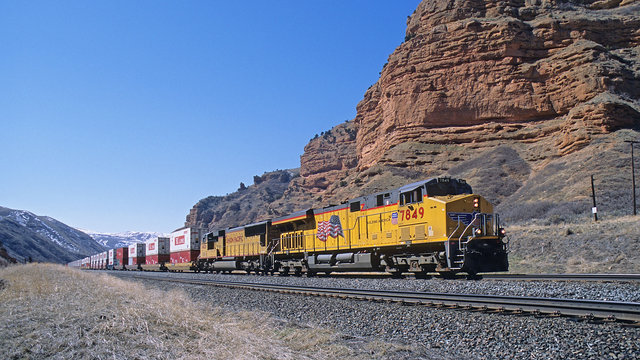
September 24, 2025
Tech on Track: Fuel Efficiency Systems Enable Safer, More Predictable Train Handling
For generations, locomotive engineers relied on experience and instinct to anticipate how trains would react to those conditions, adjusting throttle and braking mile by mile. Union Pacific’s Energy Management Systems (EMS) are transforming that process, making train handling more consistent – expanding beyond fuel efficiency to improve safety and service reliability.
“When I first started as a locomotive engineer in 2000, running a train was like feeling your way in the dark,” said Brian McGavock, Union Pacific’s general manager of the Houston Service Unit, who began railroading in 1998. “You had to think miles ahead, judge how the train would react and adjust throttle or braking by instinct. Every engineer had their own way of doing it.”
Differences in how locomotive engineers handle throttle and braking can create a tug-of-war effect along the train. This push-and-pull can cause a “break-in-two,” where a coupler device connecting rail cars comes apart under strain.
“It’s like a line of kids running while holding hands,” McGavock said. “If the lead child zigzags, the force travels down the line, and if the last kid lets go, it’s just like a rail car disconnecting.”
EMS is helping to end that problem. By continuously calculating the most efficient throttle and braking commands, EMS synchronizes power across locomotives from head to tail. It works a lot like the eco mode in a modern car – knowing when to ease off the gas to save fuel and when to apply just enough power to keep moving smoothly.
Instead of relying on each locomotive engineer’s personal style, EMS provides a single, precise standard that replaces individual tactics with proven consistency.
“It takes the guesswork out of running a train,” McGavock said. “Add in the safety benefits of Positive Train Control and smart dispatching, and EMS helps optimize the flow of the entire network.”
The results are clear: In 2025, Union Pacific saw a 78% reduction in break-in-twos when EMS was engaged. For intermodal trains – which each remove up to 550 trucks off the nation’s congested highways – the improvement was 100%.
“EMS saves fuel and keeps trains moving,” McGavock said. “That means our crews aren’t walking miles of track to apply handbrakes, our customers aren’t experiencing delays and our main line is running more smoothly. Plus, we’re constantly testing and refining the technology to make it even better.”
For McGavock, who still rides trains every month with his crews, EMS brings peace of mind.
“If the operator makes the wrong adjustment, it can create too much force that can lead to potential safety and service risks.” McGavock said. “EMS has been a game changer for both safety and service reliability. This isn’t just technology for the sake of technology – it’s the future of railroading.”